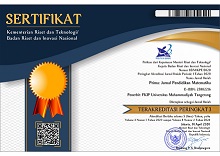THE PEDAGOGICAL CONTENT KNOWLEDGE DIMENSIONS OF MATHEMATICS TEACHER IN MATHEMATICS MODELING LEARNING
Abstract
This study aims to explain the dimensions of pedagogical content knowledge of mathematics teachers in learning mathematical modeling. Four dimensions of teacher pedagogical content knowledge for mathematical modeling: (1) Dimension of mathematical modeling theory, (2) Dimension of cognitive, (3) Dimension of learning, and (4) dimension of evaluation. The data collection is observation and interview. Based on the basic assumptions about the impact of teaching on learning, teacher competence will result in quality teaching and quality student learning. Therefore, all of dimensions should be included as mandatory components in teacher education and professional development.
Keywords
Full Text:
PDFReferences
Ang, K. C. (2016). “MathematicalModelling,Technology and H3Mathematics”. The Mathematics Educator.Association of Mathematics Educators. 9 (2) :33-47
Bahmaei, F. (2011).Mathematical modelling in primary school, advantages and challenges. Journal of Mathematical Modelling and Application : Vol. 1, No. 9, 3-13. Department of Mathematics, Shahid Chamran University of Ahvaz,Iran. www.proxy.furb.br/ojs/index.php
Ball, D.L., Hill, H.C. & Bass, H. (2005). Knowing mathematics for teaching. In: American Educator, 29 (3), 14-46.
Blum, W., & Ferri, R.B. (2009).Mathematical Modelling: Can It Be Taught And Learn? Journal of Mathematical Modelling and Application 2009. 1(1): 45-58.
Blum, W., & Niss, M. (2001). Applied Mathematical Problem Solving, Modelling, Applications, and Links to Other Subjects – State Trends and Issues in Mathematics Instruction. Educational Studies in Mathematics 22. : 37–68.
Blum, W, et al. (2011). Trends in Teaching and Learning of Mathematical Modelling: ICTMA 14. London : Springer
Borromeo Ferri, R. & Blum, W. (2010). Mathematical Modelling in Teacher Education–Experiences from a Modelling Seminar. In: Durand-Guerrier, V., Soury- Lavergne, S. &Arzarello, F. (Eds), CERME-6 – Proceedings of the Sixth Congress of the European Society for Research in Mathematics Education. INRP, Lyon 2010, 2046-2055.
Burkhardt, H. (2004). Establishing modelling in the curriculum: barriers and levers. In: Henn, Camberlin & Coxbill. (2012). Using Model-Eliciting Activities to Introduce Upper Elementary Student to Statistical Reasoning and Mathematical Modelling.
Cohen, Manion, & Morrison. (2017). Research Methods in Education. New York: Madison Avenue.
COPAM & SIAM. (2019). GAIMME (Guidlines For Assesment & Instruction In Mathematical Modelling Education). USA: COPAM, Inc. & SIAM.
DeLange, J. (1987). Mathematics, Insight and Meaning. Utrecht: CD-Press.
Doerr, H. (2007). What knowledge do teachers need for teaching mathematics through applications and modelling? In: Blum, W. et al. (Eds), Modelling and Applications in Mathematics Education. New York: Springer, 69-78.
Ebby, C. B. (2000) “Learning to teach mathematics differently: The interaction between coursework and fieldwork for preservice teachers”, Journal of Mathematics Teacher Education, Vol. 3, pp. 69-97.
Eric, C. C. M (2009). Mathematical Modelling as Problem Solving for Children in the Singapore Mathematics Classrooms. Journal of Science Mathematics Education in Southeast Asia. 32(1): 36-61
Eric, dkk. (2015). A case Study on Developing a Teacher’s Capacity in Mathematical Modelling. Singapore: The Mathematics Educator. 16(1): 45-47
Freudenthal, H. (1973). Mathematics as an Educational Task. Dordrecht: Reidel. Hartono, Y. (2015). Matematika: Strategi Pemecahan Masalah. Yogyakarta: Graha Ilmu
Gravemeijer, K., & Cobb, P. (2006). Design research from a learning design perspective. In Educational design research (pp. 29-63). Routledge.
Ikeda, T. (2007). Possibilities for, and obstacles to teaching applications and modelling in the lower secondary levels. In: Blum, W. et al. (Eds), Modelling and Applications in Mathematics Education. New York: Springer, 457-462.
Kaiser, G., Schwarz, B. & Tiedemann, S. (2010). Future Teachers´ Professional Knowledge on Modeling. In: Lesh, R., Galbraith, P.L., Haines, C.R. & Hurford, A. (Eds): Modeling Students’ Mathematical Modeling Competencies. ICTMA 13. New York: Springer, 433-444.
Kunter, M., Baumert, J., Blum, W. et al. (Eds, 2013). Cognitive Activation in the Mathematics Classroom and Professional Competence of Teachers – Results from the COACTIV Project. New York: Springer.
Kurniadi, E., et al.(2019). Kompetensi Mahasiswa dalam Mata Kuliah Pemodelan Matematika Berbasis Pengembangan Soal. Jurnal Elemen, 5(1), 54–63.
Kurniadi, E., et al. (2020). Analisis Kemampuan Pemahaman Konsep Dasar Mahasiswa dalam Mengidentifikasi karakteristik dan Menyelesaikan soal Pemodelan Matematika. Jurnal Gantang, 6(1), 9-18.
Schmidt, W.H., Tatto, M.T., Bankov, K., Blömeke, S., Cedillo, T., Cogan, L., et al. (2007). The preparation gap: Teacher education for middle school mathematics in six countries (MT21 Report). East Lansing: MSU Center for Research in Mathematics and Science Education.
DOI: http://dx.doi.org/10.31000/prima.v6i2.5381
Article Metrics
Abstract - 1072 PDF - 1073Refbacks
- There are currently no refbacks.
Prima: Jurnal Pendidikan Matematika
Program Studi Pendidikan Matematika
Fakultas Keguruan dan Ilmu Pendidikan
Universitas Muhammadiyah Tangerang
Jl. Perintis Kemerdekaan I/33, Cikokol
Kota Tangerang, Indonesia
e-mail: primajpm@gmail.com
Prima: Jurnal Pendidikan Matematika (p-ISSN: 2579-9827 | e-ISSN: 2580-2216) is licensed under a Creative Commons Attribution 4.0 International License.







